英语基础模块第2册Unit9教案
- 格式:docx
- 大小:97.53 KB
- 文档页数:4
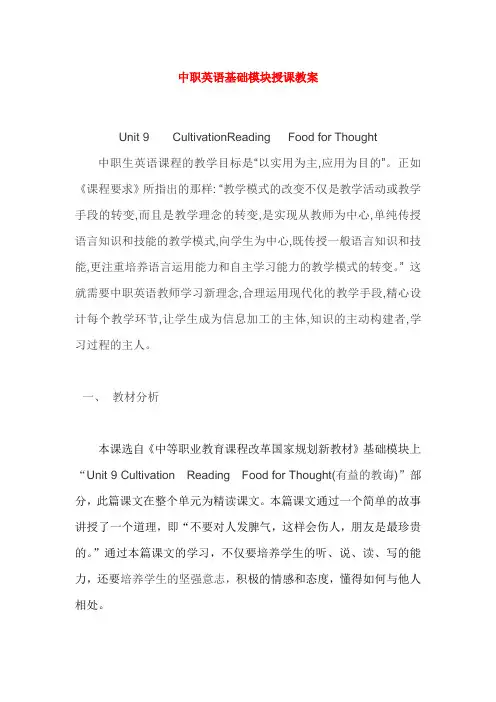
中职英语基础模块授课教案Unit 9 CultivationReading Food for Thought 中职生英语课程的教学目标是“以实用为主,应用为目的”。
正如《课程要求》所指出的那样: “教学模式的改变不仅是教学活动或教学手段的转变,而且是教学理念的转变,是实现从教师为中心,单纯传授语言知识和技能的教学模式,向学生为中心,既传授一般语言知识和技能,更注重培养语言运用能力和自主学习能力的教学模式的转变。
”这就需要中职英语教师学习新理念,合理运用现代化的教学手段,精心设计每个教学环节,让学生成为信息加工的主体,知识的主动构建者,学习过程的主人。
一、教材分析本课选自《中等职业教育课程改革国家规划新教材》基础模块上“Unit 9 Cultivation Reading Food for Thought(有益的教诲)”部分,此篇课文在整个单元为精读课文。
本篇课文通过一个简单的故事讲授了一个道理,即“不要对人发脾气,这样会伤人,朋友是最珍贵的。
”通过本篇课文的学习,不仅要培养学生的听、说、读、写的能力,还要培养学生的坚强意志,积极的情感和态度,懂得如何与他人相处。
二、学情分析我所教的班级是高一的新生,他们大多数英语基础比较薄弱, 运用英语进行交际活动的能力较差,主动学习的动力不够,然而他们的好胜心强,渴望在班集体里得到他人的承认,很在乎别人对他们的评价,求知欲旺盛,思维比较活跃。
因此,只有设置使他们感兴趣的活动,因材施教,尊重学生的个体差异,适应学生的个性发展需求,寻找适应他们的教学策略。
才能使每个学生均学有所得。
三、教学目标1. 认知目标⑴通过课文的学习,掌握下列词汇的用法have fights with lose one’s temper keep one’s temper the number of a number of not … at allbe able to⑵理解宾语从句的构成,it 做形式主语的句式⑶能较流畅地朗读课文,理解课文内容,了解文章的中心思想。
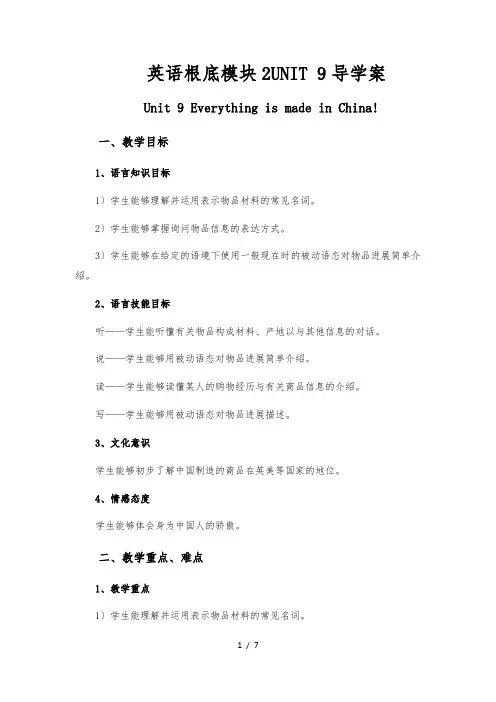
英语根底模块2UNIT 9导学案Unit 9 Everything is made in China!一、教学目标1、语言知识目标1〕学生能够理解并运用表示物品材料的常见名词。
2〕学生能够掌握询问物品信息的表达方式。
3〕学生能够在给定的语境下使用一般现在时的被动语态对物品进展简单介绍。
2、语言技能目标听——学生能听懂有关物品构成材料、产地以与其他信息的对话。
说——学生能够用被动语态对物品进展简单介绍。
读——学生能够读懂某人的购物经历与有关商品信息的介绍。
写——学生能够用被动语态对物品进展描述。
3、文化意识学生能够初步了解中国制造的商品在英美等国家的地位。
4、情感态度学生能够体会身为中国人的骄傲。
二、教学重点、难点1、教学重点1〕学生能理解并运用表示物品材料的常见名词。
2〕通过对寻找身边材料和观看图片,学生能听懂关于物品构成材料和商品信息的词汇与句型。
3〕通过对话学习,学生能够进展顾客与售货员之间的对话。
2、教学难点学生能在真实的情境中进展顾客与售货员之间的对话。
三、教学知识点1、表示颜色的常用词汇red〔红〕 white〔白〕 black〔黑〕 green〔绿〕 yellow〔黄〕 blue 〔蓝〕purple〔紫〕 gray/grey〔灰〕 brown〔棕〕 pink 〔粉〕 cream〔奶黄〕orange〔橙〕pale blue/light blue〔浅蓝〕 dark blue(深蓝)2、What is it made of? 它是什么制成的?be made of/be made from/be made in/be made into/be made up of的区别1〕be made of表示"由...制成", 一般指能够看出原材料,或发生的是物理变化。
This table is made of wood. 桌子是由木材制成的。
2〕be made from也表示"由...制成",但一般指看不出原材料,或发生的是化学变化。
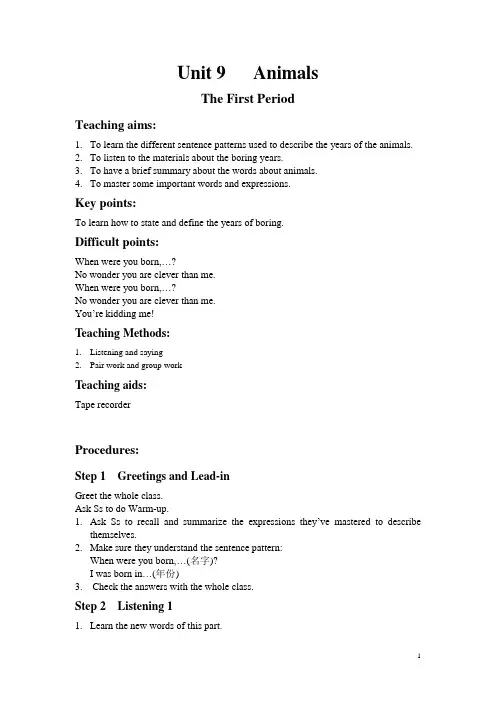
Unit 9 AnimalsThe First PeriodTeaching aims:1.To learn the different sentence patterns used to describe the years of the animals.2.To listen to the materials about the boring years.3.To have a brief summary about the words about animals.4.To master some important words and expressions.Key points:To learn how to state and define the years of boring.Difficult points:When were you born,…?No wonder you are clever than me.When were you born,…?No wonder you are clever than me.You’re kidding me!Teaching Methods:1.Listening and saying2.Pair work and group workTeaching aids:Tape recorderProcedures:Step 1 Greetings and Lead-inGreet the whole class.Ask Ss to do Warm-up.1.Ask Ss to recall and summarize the expressions they’ve mastered to describethemselves.2.Make sure they understand the sentence pattern:When were you born,…(名字)?I was born in…(年份)3. Check the answers with the whole class.Step 2 Listening 11.Learn the new words of this part.Notes:rat n. 老鼠,耗子ox n. (pl.oxen)牛;公牛tiger n. 老虎rabbit n. 兔子dragon n. 龙goat n. 山羊monkey n. 猴子rooster n. 公鸡,雄鸡No wonder 不足为奇,并不奇怪;难怪2. Ask Ss to look at the listening materials before listening.3. Play the tape. Ask Ss to do the match and give the reasons for their choices.3.Play the tape again, and then check the answers with the whole class.Script of listening:1.Feng Xiao was born in the year of the Dog..2.David was born in the year of the Ox.3.Joseph Cort was born in the year of the Tiger.4. Geoge Brown was born in the year of the Dragon.5.Lilian White was born in the year of the Monkey.Step 3 Dialogue 11.Have students discuss the relationship between the two speakers and where thedialogue take place.2.Explain the important phrases and divide the students into 3 groups to discuss andcomplete the dialogue with the words given below.3.Play the tape and ask Ss to read after it, and then ask Ss to play the dialogue.4.Remember the following important phrases:When were you born,…?No wonder you are clever than me.When were you born,…?No wonder you are clever than me.You’ kidding me!Step 4 Role Play 11.Practise the important phrases and words.2.Ask Ss to practise the dialogue as Dialogue 1. Ask some Ss to play the dialogue infront of the class.3.Ask Ss to practise more about this pattern.Step 5 Homework1.Make a dialogue in pairs with the knowledge learnt today.2.Copy the new words three times.3.Recite the dialogue 1.The Second Period Teaching aims:1.To learn some important prepositions used with adjectives.2.To learn how to describe keeping pets.Key points:How to describe keeping pets.Difficult points:I’m thinking of buying…They can keep the water clean and make the tank look much prettier. Teaching Methods:1. Listening and saying2. Pair work and group workTeaching aids:Tape recorderProcedures:Step 1 Greetings and Lead-inGreet the whole class.Review the important phrases learned last period.Step 2 Listening 21.Learn the new words of this part.Notes:underwater adj. 水下的;用于水下的tank n. (储放液体或气体的)箱;槽bowl n 碗;钵;盆.think of 思考,考虑It’s up of you. 由你做主,取决于你。
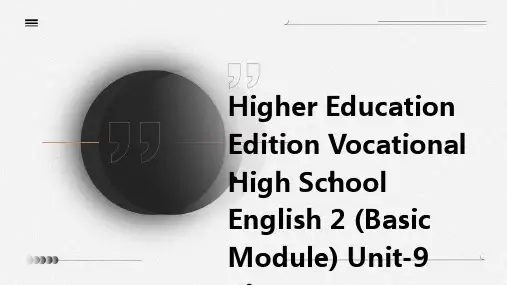
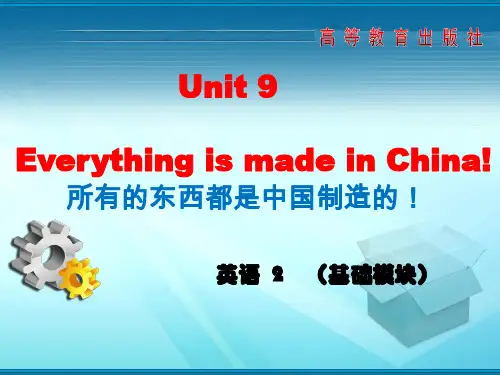
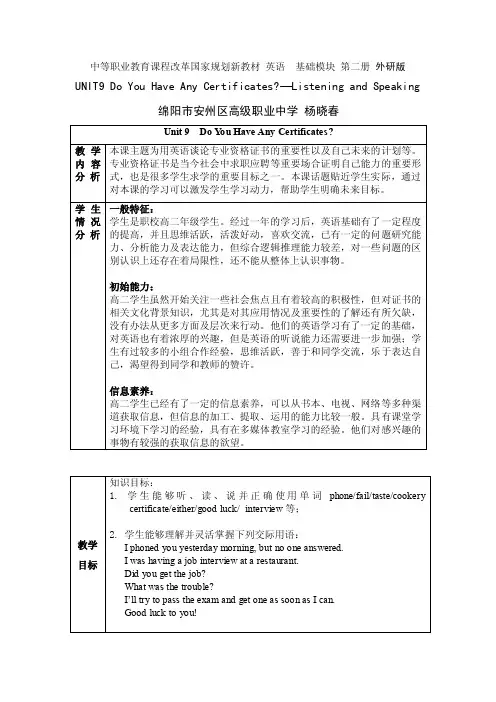
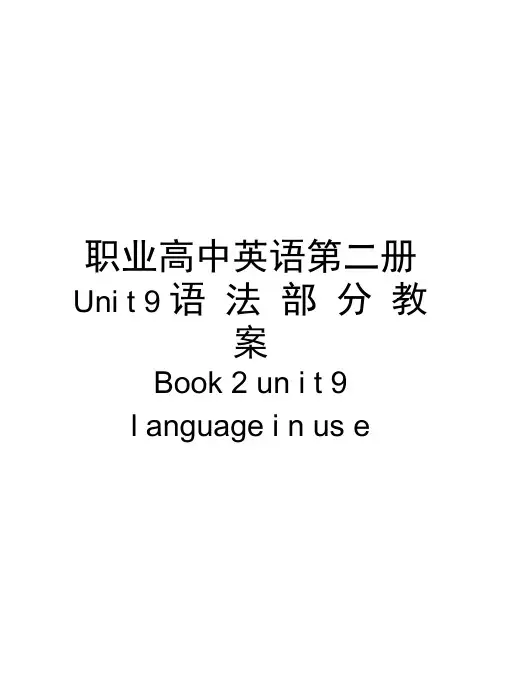
职业高中英语第二册Uni t 9 语法部分教案Book 2 un i t 9l anguage i n us e仅供学习与交流,如有侵权请联系网站删除谢谢2精品资料汨罗市职业中专学校教学方案设计(首页)精品资料汨罗市职业中专学校教学方案设计(正页)仅供学习与交流,如有侵权请联系网站删除谢谢3仅供学习与交流,如有侵权请联系网站删除谢谢4精品资料精品资料仅供学习与交流,如有侵权请联系网站删除谢谢5精品资料仅供学习与交流,如有侵权请联系网站删除谢谢6“主语+谓语+宾语”的句子转化成被动语态分为三步:将主动 语态的宾语变成主语,宾语如果为人称代词,则要使用主格形 式;将主动语态的谓语变成被动式 be +过去分词;主动语态 的主语变成被动语态句中by 的宾语,主语如果为人称代词, 转换后要使用宾格形式。
主格 宾格 所有格 宾格所有格 第一人称 I 、we me 、us my 、ourmine 、ours 第二人称 you youyouryours 第三人称单 she/he/ her / him her/hisher s hisit it its its 复数 they them their theirs Eg :People speak En glish in the World.主 谓宾f English __ is_spoken by_people in the World. 主 谓 by+宾语 They make shoes every day. 主 谓 宾f Shoes are made by them every day. 主 谓 by+宾语He gives us some suggesti ons.f We are give n some suggesti ons by him. She teaches me the song. f I am taught the song by her. I clea ned my bedroom last day.f My bedroom is clea ned by me last day. The whole World knows Ein ste in.f Ei nste in is known by the whole World. My mother cooks the meal at my home.f The meal is cooked by my mother at my home. 四、 •被动语态的否定形式:五、 被动语态的否定形式是在肯定句中的 be 动词后加not 构精品资料仅供学习与交流,如有侵权请联系网站删除谢谢7仅供学习与交流,如有侵权请联系网站删除谢谢8精品资料He was born in October ,1989 .精品资料仅供学习与交流,如有侵权请联系网站删除 谢谢9被动语态值得注意的事项:1. 我们之所以用被动语态是因为我们不清楚动作的执行者、或没有必要指出动词的执行者等。
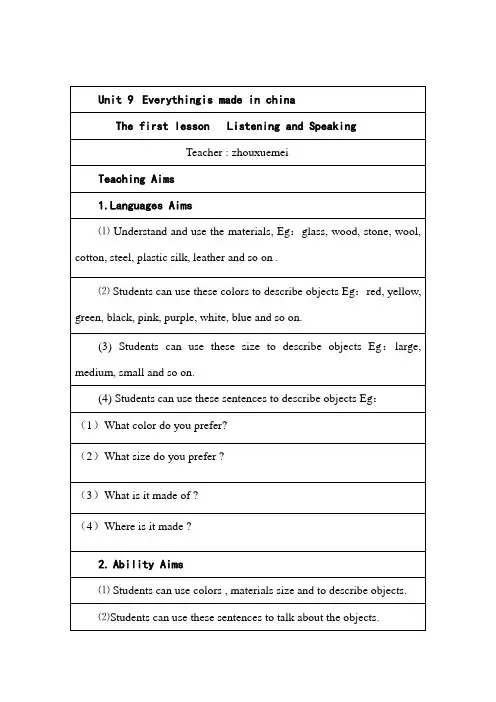
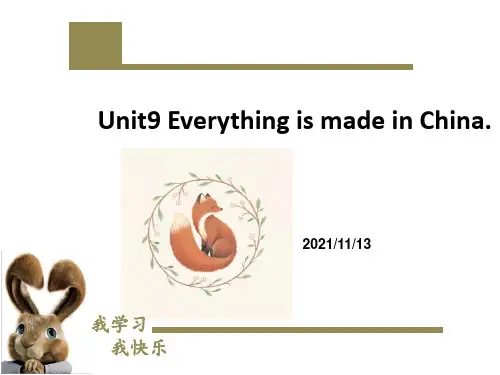

Unit 9 Chinese knot is used to express good wishes(第二课时教学设计)一、教材分析1.教学内容本课时系教材《英语基础教程》(2)第九单元的第二课时,包括Reading and writing 部分,具体内容为了解认识一些介绍产品的英文表达;读懂关于介绍产品的短文;能根据关键句型写出Apocket2000的简要介绍;了解一些科技知识。
2.教学重点、难点⑴教学重点学会用be used to,make up,combine … into …, in case,disconnect … from … ,provide … for…等单词和短语介绍物品特点的句型;⑵教学难点灵活正确使用介绍物品特点的的句型;能根据关键句型写出物品特点。
二、教学目标1. 知识目标⑴掌握与产品相关的词汇,如:automatically ,capacity,charge,compact,handicraft,intelligent,multifunctional,name,specification,storage,stylish,transfer,typical.⑵掌握介绍产品所使用的句型,如:It is specially designed for---It is mainly used to…Power storage and data transfer are combined with---Apocket 2000 also provides complete protection for iPhonein case of2. 能力目标(1) 灵活正确使用介绍产品的句型;(2)能根据关键句型写出产品特点。
3. 情感目标通过对Apocket2000的了解和简要介绍,了解一些科技知识。
三、教学步骤Step One Lead-in1. Review:Ask three or four students to introduce Chinese tea in front of the whole class tohelp students to review the key sentence patterns learned last class.-It is used to …- It is used for …- It’s called …(设计意图:通过学生上台介绍,让学生复习所学短语,为后面深入一步的学习做好准备。

《新编实⽤英语》教案第⼆册Unit9Unit Nine Applying For a JobI. Objectives:By the end of this unit, the students should be able to:1. Read and translate job ads2. How to attend interviews, how to accept or decline a job offer3. How to write application letter and resume4. Knowledge about job seeking5. Useful expressions and language pointsII. IntroductionLead-in(导⼊): First, the students are asked to discuss the topic—Applying For a Job. Then their opinions are written down on the blackboard. Finally, the introductory remarks will be made by the teacher as follows:What are you going to do in the future? Find ing a good and satisfying job may be everyone’s dream and to some extent it is the key to success. If you are looking for a job, besides a proper resume, it is most likely that you will be asked for a job interview. Therefore, your introduction in the resume and performance in the job interview play an important role in getting the job. In this unit you'll learn something more about this practical topic.1. We should try to get some information about different jobs from newspapers,advertisements or other places and know how to understand English advertisements.2. Secondly, prepare your personal date record, references and then write your resume.3. Thirdly, write an application letter and complete an application form.4. At last, attend interviews, accepting or declining a job offer.III. Teaching Procedures:Section 1 Talking Face to FaceStep 1 Read and translate some job adsSample 1Sample 2We require a person forfull-time sales in our clothing department. No salesexperience is necessary, as we will train. Must beneat in appearance and strong people skills are anadvantage. Plenty of opportunity for advancementmeans this is a great start if you are looking for anew job in sales!Send cover letter with resume to :EDGARSHuman Resources manager (⼈⼒资源部经理)126 Prospect Hall roadMississauga, OntarioM4W 1K0Advertisement 1Sample 3Step 2 Read some dialogues about job interview and try to learn how to attend job interview.1.SamplesSample 1 Having a job interviewApril: Hello. Please come in and sit down. Your name is Li Fan, I see. Li: Yes.April:So why don’t you tell me about yourself first, Mr. Li?Li: Uh, certainly. My name is Li Fan. I’m from Shanghai, But I’mliving in Shanghai now. I graduated from Binhai Applied Technology Collegelast year.April: Ok Very good. What job are you applying for?Li: Well, I want to apply for the position advertised by your company---a full time job in sales. April: What courses did you take in your college?Li: My major was clothing design.April: Really? Do you have any sales experiences?Li: Yes. After graduation, I worked as a salesman for a company forone year.April: What about languages?Li: I can speak English very well.April: I see your English is clear, And you dress professionally, too.Hum. Please wait one momentSample 2: Applying for a jobCampos: Come in. Please sit down.Yu: Thanks. Mr. Campos. I'm Yu Lihong.Campos: OK, what can I do for you, Mr. Yu?Yu: I saw your ad for a production technologist yesterday, And Iwant to apply for that position.Campos: Oh, Would you tell me why you are interest in that job?Yu: Well, I got a Mechanical Engineering diploma three years ago,and I've been working in Precascon Mechanical Factory for twoand a half years.Campos: Why do you want to leave (change) the present job?Yu: Well, I'd like to work in a large company like yours that offersmore opportunities for growth (promotion, advancement). Campos: OK. Mr. Yu. It seems that you have the qualifications, Pleasefill out the applications form. You'll be hearing from us withintwo weeks.Yu: Thank you for giving me the chance.Campos: You're most welcome, and good luck.Notes: The most important question for an applicant who want to changehis present job is "why do you want to leave the job?".---Because I like a change, challenge, to widen my experience inthis field ……2. Tasks after class(1)Talk with your partner about your imagined experience as asalesman.(2)Think of a job and tell your partner why you think you are suitablefor it.(3)Tell your friend about your reason for choosing to be a travelingsales agent.(4)Discuss with your partner how to answer the question “Tell usyou idea about this job.”Step 3 Useful sentence patterns about job interview.1.Questions you should think about :1). Why are you interested in the job? Know what kind of person you are, List your advantages over other applicants2). Why do you want to join the company? or what contributions can you make to the company? Know some information about the company (the advantages of the company, some facts about it, the business, the organization, the number of staff, the good future)3). How to sell (present your personality, nature ) yourself confidently? Show your enthusiasm for hard work and your abilities to handle problems.4). How should the applicants behave in an interview? ( walk in quickly, greet warmly, shake hands firmly, sit properly, give no simple yes-no answers and dress professionally.5). How much salary will you expect? What is the salary? May I ask about the salary? 25,000 dollars a year.6). What is the working time? Can you work over time?Work weekdays from 9:00 a.m. to 3: p.m., with half an hour lunch break. (From 5 to 9 p.m. every day except Sundays2. Useful sentences(1) The questions asked by interviewers:(⾯试者询问的问题)Why don’t you begin by telling me something about yourself?先讲⼀下你的个⼈情况,好吗?Would you tell me about your studies?讲⼀下你的学历。
Unit 9 Chinese knot is used to express good wishes〔第一课时教学设计〕一、单元内容分析本单元的话题是介绍某物品。
教学重点是应用介绍物品常见的词汇和句型。
具体为:能够听懂谈论某物品特点的对话;正确及熟练运用英语谈论某物品的特点功能;能读懂关于介绍某物品特色的文章;简单描绘相关的物品;同时了解一些相关的传统文化和科技知识。
本单元的语法点为一般现在时的被动语态。
本单元将会学习以前学生从未接触过的被动语态,同时又会学习一些具有时代感的词汇,因此具有十分重要的地位。
教师应通过合理的设计,循序渐进地融入新内容,有效的完成词汇听、说、读、写四个任务。
在谈论相关产品及阅读相关文章的过程中,拓宽学生的视野,感受传统文化与科技的魅力。
本单元设计成四个课时:第一课时 Lead in + Listening and speaking第二课时 Reading and writing第三课时 Grammar focus (Passive Voice of the simple present tense)第四课时 Vocabulary practice + Supplementary reading二、分课时教学设计第一课时 Lead in + Listening and Speaking一、教材分析1.教学内容本课时系教材?英语根底教程?〔2〕第九单元的第一课时,包括Lead-in & Listening and speaking两局部,具体内容为:课文中出现物品的词汇,听懂并能谈论和答复有关这些物品的对话。
2.教学重点、难点⑴教学重点描绘剪纸、中国结等物品的词汇和句型;听懂和谈论介绍相关物品的词汇和句型;听懂和谈论有关物品介绍的简单对话。
⑵教学难点在模拟或真实语境中谈论相关物品。
二、教学目标1.知识目标⑴ 掌握介绍物品相关的词汇,如:paper cut, smart phone, Chinese knot, silk, tea pot, smart watch, express good wishes, serve tea, decorate windows, show people’s heart rate, communicate with others, from start to finish, according to, how about⑵掌握介绍物品所使用的句型,如:---What color is it?--- What is it made of?--- What does it mean?--- It is used to …--- It is used for …--- It’s called … It is …2.能力目标⑴学生能听懂关于介绍物品的对话;⑵学生能应用根本句型进行相关物品的简单介绍;(3)对介绍物品的根本词汇和句型到达听、说应用的程度。
Unit 9 Everything is made in China(第一课时教学设计)一、教材分析1.教学内容第一课时的内容包括Lead-in & Listening and speaking两部分,主要内容是关于物品构成材料的词汇和购物的对话。
2.教学重点、难点(1)教学重点①通过对寻找身边材料和观看图片,学生能听懂关于物品构成材料和商品信息的词汇与句型。
②通过对话学习,学生能够进行顾客与售货员之间的对话。
(2)教学难点学生能在真实的情境中进行顾客与售货员之间的对话。
三、教学目标1.知识目标(1)学生能够掌握关于物品构成的材料和商品信息的词汇,如:glass, cotton, plastic, wood, stone, wool, silk, steel, leather, size, price, material, color, place of production, design, be made of, medium, etc。
(2)学生能掌握购物时所使用的句型,如:What can I do for you?What color do you prefer?I want a large/ medium/ small size.What is it made of?Where is it made?四、教学步骤Step One Lead-inBrainstormingTeacher : What materials are they?Ask students to discuss what materials they can find around them in the classroom.Promotion: What’s your coat made of?What’s the table made of?Step T wo Words Study1. Match the objects with their materials. (Activity 1 )Teacher : Show the words and related pictures of the objects on the screen.Students: Match the objects with their materials.Step Three Listening1. Pre-listeningTeacher: Ask several students about their clothes. The dialogue are as follows:T: What color is your coat?S: It’s ...T: What’s it made of?S: It’s made of ....T: What size is it?S: It’s size L.2. While-listening(1)Listen and answer the questions. (Activity3)(2)Listen again and tick the things they are talking about. (Activity 4)3. Post-listening ( class work and pair work )Step Four Speaking1. Read aloud after the tape and pay attention to the underlined sentences. (Activity 6)Ask students to read the underlined sentences and memorize.What is it made of?It’s made of silk.Where is it made ?I t’s made in China.2. Role play the dialogue between a customer and a shop assistant with the information given. (Activity 7)(1)Teacher makes short dialogues with several students first.Step Five DiscussionTalk about the things you bought recently in pairs.Sample: A: I bought a new scarf last weekend.B: Where is it made?Step Six Homework1. Remember and search more materials about the objects around you.2. Make up a dialogue of asking and giving information about goods.五、板书设计Unit 9 Everything is made in China(第二课时教学设计)一、教材分析1.教学内容本单元阅读活动的目的是训练学生理解描述某人一天购物经历的短文,让学生能在一般的生活、工作语境中使用正确的叙事方式,并能完成相关语言(笔头)输出任务,同时读写活动也为学生完成单元任务作相关的语言准备。
Unit 9 Everything is made in China【教学步骤】Period 1●Step 1 lead-in1.介绍本单元的主题。
2.提示学生课桌椅,书本,窗户的构成材料是什么。
3.引出“sth be made of sth”“……是由……制成的”这一用法。
●Step 2 look and match1.教师先带学生熟悉方框中不同材料以及句子中物品的英文名称。
跟读一遍。
2.学生自己选词填空。
3.点名抽查并反馈。
●Step 3 learn the new words学习新单词。
跟读两遍,学生自己读一遍,给5分钟时间学生自己记单词。
再读多一遍。
●Step 4 read and match1.学生读句子并连线。
2.请五名学生在黑板上连线。
3.全班核对答案并反馈。
4.读一遍已搭配好的对话。
Period 2●Step 1 listen and answer1.教师解读问题,引导学生对听力内容进行猜测。
2.播放两遍录音,学生回答问题。
3.点名抽查并反馈。
●Step 2 listen and tick1.教师对题目要求做解释,提问学生方框内出现的选项意思。
就size, material,colour展开头脑风暴,以复习136页的内容。
2.放两遍录音,学生根据录音选出对话中讨论的内容。
3.全班一起核对答案。
●Step 3 listen and decide1.给10秒钟学生自己阅读句子。
2.播放两遍录音,学生判断正误。
3.点名检查并逐句播放录音核对答案。
●Step 4 read and notice1.学生自己先看一遍对话,教师讲解对话。
再跟读一遍,学生自己读一遍。
2.着重划线句子。
3.与同桌练习对话。
请两组学生读一遍。
●Step 5 talk and act1.教师与班上一名学生以笔做示范对话。
2.解释范例以及提示信息,要求学生与同桌练习对话。
3.对两组学生进行检查。
●Step 6 talk and practice1.参照范例,两人一组讨论最近买的物品。
英语基础模块2UNIT-9导学案英语基础模块2UNIT 9导学案Unit 9 Everything is made in China!一、教学目标1、语言知识目标1)学生能够理解并运用表示物品材料的常见名词。
2)学生能够掌握询问物品信息的表达方式。
3)学生能够在给定的语境下使用一般现在时的被动语态对物品进行简单介绍。
2、语言技能目标听——学生能听懂有关物品构成材料、产地以及其他信息的对话。
说——学生能够用被动语态对物品进行简单介绍。
读——学生能够读懂某人的购物经历及有关商品信息的介绍。
写——学生能够用被动语态对物品进行描述。
3、文化意识学生能够初步了解中国制造的商品在英美等国家的地位。
4、情感态度学生能够体会身为中国人的骄傲。
二、教学重点、难点1、教学重点1)学生能理解并运用表示物品材料的常见名词。
2)通过对寻找身边材料和观看图片,学生能听懂关于物品构成材料和商品信息的词汇与句型。
3)通过对话学习,学生能够进行顾客与售货员之间的对话。
2、教学难点学生能在真实的情境中进行顾客与售货员之间的对话。
三、教学知识点1、表示颜色的常用词汇red(红)white(白)black(黑)green(绿)yellow(黄)blue(蓝)purple(紫)gray/grey(灰)brown(棕)pink (粉)cream(奶黄)orange(橙)pale blue/light blue(浅蓝)dark blue(深蓝)2、What is it made of? 它是什么制成的?be made of/be made from/be made in/be made into/be made up of的区别1)be made of表示"由...制成", 一般指能够看出原材料,或发生的是物理变化。
This table is made of wood. 桌子是由木材制成的。
2)be made from也表示"由...制成",但一般指看不出原材料,或发生的是化学变化。
外研版基础模块(修订版)第二册
Unit 9 What is your dream job?
一、单元整体解读及分析
二、分课时教学设计
第1课时
第2课时
第3课时
第4课时
语教师。
任职九年来,一直工作在教育教学第一线,参与编写北京市中职试用教材第一册教学课件;指导学生参加市、区级英语知识技能竞赛、英文板报比赛获一、二、三等奖;撰写论文多次获国家、市、区级一、二、三等奖,做各类公开课、研究课、评优课十余节,均取得优异成绩,广受听课教师好评。
在第三届“外研社杯”全国中等职业学校英语教师教学技能大赛中获一等奖,被评为北京市崇文区优秀青年教师。